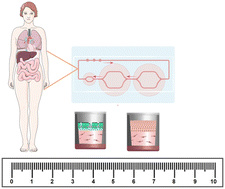A similarity scaling approach for organ-on-chip devices†
Abstract
Organ-on-chip devices (OoCs) provide more nuanced insights into (patho)physiological processes of the human body than static tissue models, and are currently the most promising approach to emulating human (patho)physiology in vitro. OoC designs vary greatly and questions remain as to how to maximize biomimicry and clinical translatability of the in vitro findings. Scaling is critical, yet has largely been ad hoc, consisting in matching one or a few variables between the OoC and the target organ. This has limited the predictive value of OoCs. Here, we propose a systematic approach based on the principle of similitude widely used in the physical sciences, and present three case studies from the recent literature to demonstrate how the approach works. A lung-on-a-chip and a liver-on-a-chip both satisfied important similarity criteria, and therefore yielded results that were in good agreement with clinical data. A gut–liver system failed to satisfy a key criterion of kinematic similarity, and yielded unphysiological pharmacokinetic responses in vitro. The similarity scaling approach promises to improve markedly the design and operation of organ- and human-on-chip devices.



 Please wait while we load your content...
Please wait while we load your content...